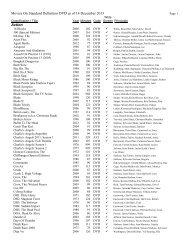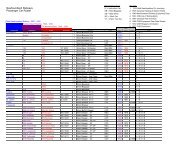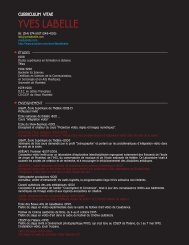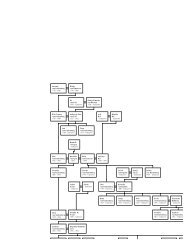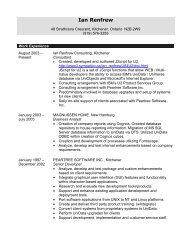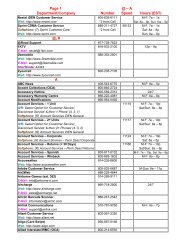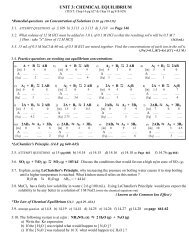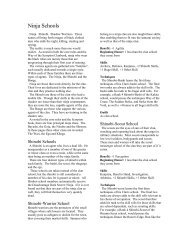Amateur Radio Repeater Basics - Sympatico
Amateur Radio Repeater Basics - Sympatico
Amateur Radio Repeater Basics - Sympatico
Create successful ePaper yourself
Turn your PDF publications into a flip-book with our unique Google optimized e-Paper software.
<strong>Amateur</strong> <strong>Radio</strong> FM <strong>Repeater</strong> <strong>Basics</strong>Al Duncan – VE3RRDUpdated October 2007For a list of frequencies of operation for Canadian <strong>Amateur</strong> <strong>Radio</strong> operations, refer to RBR-4 “Standardsfor the Operation of <strong>Radio</strong> Stations in the <strong>Amateur</strong> <strong>Radio</strong> Service” which can be found on the IndustryCanada website at:http://strategis.ic.gc.ca/epic/internet/insmt-gst.nsf/en/sf05478e.htmlSchedule I lists frequencies for the various “ham bands” in use (Canada is in IARU Region 2). The bandsmost often used for FM repeater operations (listed in order of popularity) are:144 – 148 MHz referred to as the “2 meter” band (2M band)430 – 450 MHz referred to as the “440 band” or the “70cm band”50 – 54 MHz referred to as the “6 meter band”28 – 29.7 MHz referred to as the “10 meter band”220 – 225 MHz referred to as the “220 band” or “1 ¼ meter band” or “125 cm band”902 – 928 MHz referred to as the “900 band”1240 – 1300 MHz referred to as the “23 cm band”Note that the name “2 meter”, “70 cm” etc. refers to the approximate wavelength of the radio wave.Within these frequency ranges, “standards” have been created as to what frequencies can be used forrepeater transmit (output) and receive (input).In most cases, FM (frequency modulation) is used with repeater operations. The most popular transceiversavailable today will either be “2M only” or “2M/440 dual-band”, with the occasional model offering threeor even four bands of operation.SimplexWhen you wish to talk to another ham without using a repeater, a “simplex” frequency is used. Simplexrefers to the fact that everyone involved in the radio communications are both transmitting and receivingon the same “single” frequency. In simplex communications, only one person can talk (transmit) at a time,and he cannot hear (receive) anyone else while he is transmitting.Popular designated simplex frequencies are (you may find others in various parts of Canada/U.S.):2 meter band FM simplex frequencies146.520 MHz (often called “52” or “652”) This frequency is also the “national calling frequency”146.550 MHz146.580 MHzThere are also 6 less common simplex frequencies from 147.420 through 147.570 (30 KHz spacing)Note that 146.565 MHz is reserved for fox-hunts (hidden transmitter hunts) in Canada and the U.S.440 band FM simplex frequencies446.000 MHz national calling frequency446.000 through 446.175 MHz (25 KHz spacing is often used)6 meter band FM simplex frequencies52.525 MHz national calling frequency51.100 through 51.600 MHz, most common being 51.500, 51.520, 51.540, 51.560, 51.580, 51.6001
10 meter band FM simplex frequencies29.600 MHz national calling frequency29.610 MHz29.500 MHz220 band FM simplex frequencies223.400 through 223.520 MHz (20 KHz spacing)900 band FM simplex frequencies906.500 MHz national calling frequency23 cm band FM simplex frequencies1294.500 MHz calling frequencySimplex operation• Buildings, trees and hills can block simplex signals after a few miles• On the other hand, simplex signals can go as far as “line-of-sight” allows• Transmitting from a mountain top allows simplex signals to go for hundreds of kilometers• Roof-top (and car roof-top) antennas help simplex signals go farther• Remember, when using simplex - “the higher, the better”Full-duplexThis mode is generally not used by <strong>Amateur</strong> <strong>Radio</strong> Operators. Full duplex permits simultaneoustransmitting and receiving (talking and listening) the same as on a normal house telephone. In radiocommunications, separate transmit and receive frequencies must be used for full-duplex – note that therewill be no “push-to-talk” microphone button. A repeater operates in a full-duplex mode.Half-duplexUsed by <strong>Amateur</strong> <strong>Radio</strong> operators when communicating through repeaters; where two separatefrequencies are used for transmitting and receiving as in full-duplex, but the transceiver can only transmitor receive (not both simultaneously). A push-to-talk button on the microphone is used to switch thetransceiver from the receive mode to the transmit mode.2
What is a repeater?A repeater is a full-duplex radio which receives signals on one frequency and simultaneously re-transmitsthem on another frequency, usually with higher power and from a better location with greatercommunications coverage range. A repeater greatly extends the operating range of amateur mobile andhand-held transceivers.In the drawings, the repeater is shown broken down into its main parts:• a transmitter (TX)• a receiver (RX)• a duplexer filter assembly which allows the transmitter and receiver to both operate at the sametime through a single antenna (prevents the repeater TX from desensitizing the RX).• a repeater controller (the brains), which takes care of keying up the TX when a signal appears atthe RX input, periodically transmitting identification in morse code or voice etc.3
In order to have your hand-held or mobile radio signal retransmitted by the repeater, your radio mustreceive on the repeater’s transmit frequency and transmit on the repeater’s receive frequency. When in thereceive mode, your radio will be tuned to the repeater output frequency. If you press the push-to-talkbutton, the radio will automatically change to the repeater input frequency and begin transmitting.The repeater input (receive) frequency can be either higher or lower in frequency than the repeater output(transmit) frequency. If it is lower (such as 146.850 output/146.250 input) then the repeater frequency iswritten as 146.850 – (the minus sign indicating that the repeater input is below the output frequency). If itis higher (such as 147.000 output/147.600 input) then the frequency is written as 147.000 + (the plus signindicating that the repeater input is above the output frequency).Standard FM repeater “offsets” (difference between output and input frequencies) are:2 meter band 600 KHz440 band 5 MHz6 meter band 1 MHz10 meter band 100 KHz220 band 1.6 MHz900 band 12 MHz23 cm band 12 MHzNote that all modern transceivers will automatically select the proper offset for the frequency you use.Designated FM repeater frequenciesA listing of most of the repeaters in this part of Ontario can be found on the “Western New York -Southern Ontario <strong>Repeater</strong> Council” website at: http://www.wnysorc.org/repeaterlist.htmlNote that this list only includes repeaters that have been registered with the WNYSORC by the club orHam <strong>Radio</strong> Operator that operates it (so some that can be heard in this area may be missing from the list).2 meter bandoutput: 145.100 to 145.500 MHz input: 144.500 to 144.900 MHz146.610 to 147.000 146.010 to 146.400147.000 to 147.390 147.600 to 147.990440 bandoutput: 442.000 to 445.000 MHz6 meter bandoutput: 53.000 to 54.000 MHz220 bandoutput: 223.910 to 225.000 MHzinput: 447.000 to 450.000 MHzinput: 52.000 to 53.000 MHzinput: 222.310 to 223.400 MHz10 meter band (repeater output/input frequencies)29.620/29.520 MHz 29.630/29.530 MHz29.640/29.540 MHz 29.650/29.550 MHz29.660/29.560 MHz 29.670/29.570 MHz29.680/29.580 MHz 29.690/29.590 MHz4
<strong>Repeater</strong> EtiquetteThe first and most important rule before using a repeater is to LISTEN FIRST – make sure the volume onyour radio is turned up and that the squelch level is not set too high. Nothing is more annoying thansomeone that "keys up" in the middle of another conversation without first checking to make sure therepeater is free. If the repeater is in use, wait for a pause in the conversation (when no one is keying therepeater) and simply announce your callsign and wait for one of the other stations to acknowledge yourcall.Remember that this is not CB, so refrain from using CB lingo such as 10-4, “what’s your handle”, orBREAKER. The word BREAKER or BREAK, BREAK on Ham <strong>Radio</strong> is commonly used to indicate thatyou have priority or emergency information to pass.When you are using the repeater, leave a couple of seconds between exchanges to allow other stations tojoin in or make a quick call. Most repeaters have a "Courtesy Tone" (a short beep or series of beeps) thatwill help in determining when the repeater has un-keyed.<strong>Repeater</strong>s usually have a time-out function that will shut down the transmitter if the repeater is held intransmit mode for too long a time (normally two to four minutes). This ensures that if someone'stransmitter is stuck on for any reason, it won't hold the repeater's transmitter on indefinitely. Of coursethis also means that if someone is too long-winded, and doesn’t periodically un-key his microphone toreset the time-out timer, those listening to him will hear the repeater controller announcement“REPEATER TIME OUT” followed by silence and then “TIME OUT CANCEL” when he does finallyun-key his microphone.Some <strong>Repeater</strong> Definitions and Ham <strong>Radio</strong> Slangaccess code - one or more numbers and/or symbols that are keyed in with a telephone key pad to activate a repeater functione.g autopatch, link to another repeater etcadjacent channel interference – the interference resulting when a strong signal from another repeater occurs close to therepeater frequency you are monitoring. Your transceiver receiver is unable to reject this signal which may be only 15 or 20KHz off frequency (see also co-channel interference and desense).autopatch - a device that interfaces a repeater to the telephone system to permit repeater users to make telephone calls. Oftencalled a "patch"boat anchor – old, usually big radio equipment (often using tubes)break - the word used to interrupt a conversation on a repeater , often to indicate that there is an emergencybrick – a small, solid state amplifierbureau – clearing house for QSL cardscans - headphonescarrier - an unmodulated (no speech) transmitter signalclear – finished with the frequency, as in “VE3GCB clear”CTCSS (Continuous Tone-Coded Squelch System) - This is a sub-audible tone transmitted by your radio in addition toyour voice signal. When it is equipped with a CTCSS decoder, a repeater will not function unless it hears the CTCSS tone andthe "carrier" signal from your transmitter. Different CTCSS tones are in use for different repeaters or areas. These may beapplied to input or output frequencies, or both. CTCSS tones are used to minimize the effects of co-channel interference due toband-openings causing reception of distant signalsCommon CTCSS tone frequencies in Hz67.0 74.4 82.5 91.5 100.0 114.8 127.3 141.3 156.7 179.9 203.5 218.1 233.669.3 77.0 85.4 94.8 107.2 118.8 131.8 146.2 162.2 186.2 206.5 225.7 241.871.9 79.7 88.5 97.4 110.9 123.0 136.5 151.4 173.8 192.8 210.7 229.1 250.3channel - the pair of frequencies (input and output) used by a repeaterchannel spacing - the frequency spacing between adjacent frequency allocations - may be 50, 30, 25, 15 or 12.5kHz,depending upon the convention in use in the area of the repeaterclear – a word meaning I’m finished with this frequency, someone else can use it (as in “VE3GCB clear”)closed repeater - a repeater whose access is limited to a select group (see also open repeater)5
cloud warmer – an antenna that radiates mostly straight upco-channel interference - the interference resulting when a repeater receives signals meant for a distant repeater on thesame frequency pair (or when you hear a distant repeater on the same frequency pair as the local repeater)controller - the control system (computer) within a repeater which may include turning the repeater on-off, timingtransmissions, sending the identification signal, controlling the autopatch and CTCSS encoder/decodercontrol operator - the amateur radio operator who is designated to control the repeatercourtesy tone - an audible indication that the repeater has unkeyed, and a user may go ahead and transmitcoverage - the geographic area within which the repeater provides communicationscross-band - the process of transmitting on one ham band and receiving on anotherDTMF - see tone paddesense (desensitization) - the reduction of receiver sensitivity due to overload from a nearby transmitter (usually on adifferent frequency from the one you are monitoring)double – to “double” with someone occurs when two people both start transmitting at the same time. The one that un-keys histransmitter first will hear the other person continuing to talk and realize he had doubled with him. A third ham would heareither the stronger signal only, or if they are similar in signal level into the repeater – an unintelligible garble of noise.dropping out - the situation, while using a repeater, when your signal does not have enough strength to keep the repeaterkeyed up (see also picket fencing)duplex - a mode of communication in which you transmit on one frequency and receive on another frequency (see also halfand full duplex)duplexer - highly selective filter (sometimes called a cavity filter) which allows a repeater's transmitter and receiver to shareone antenna without interfering with each otherDX – stations in far off countriesDXing – the art of working stations in far off countries (primarily applies to HF)DXpedition – a trip by a group of hams to a usually remote location in the world to work as many stations as possibleElmer – am experienced ham who helps newcomers to the hobbyERP (effective radiated power) - radiated power, allowing for transmitter output power, line losses and antenna gainEyeball QSO – a face-to-face conversation between hams (see also QSO)Final – could mean the power amplifier output tubes or transistors, but is often used to mean the final communication – as in“I’ll turn it over to you for your final”frequency coordinator - an individual or group responsible for assigning channels to new repeaters with minimalinterference to existing repeatersfrequency modulation (FM) - a method of modulation, where the strength of the signal is constant, but the frequencyvaries with the strength of the voice, and the rate of frequency change varies with the pitch of the voicefull duplex - a mode of communication in which you transmit on one frequency while you simultaneously receive on anotherfrequencyfull quieting - a received signal that contains no noise (no hiss). If your signal is not full quieting into a repeater, the repeaterwill retransmit your voice along with any noise or hiss it receives. Increase TX power until full quieting is reachedGHz (Gigahertz) – a unit of frequency measurement equal to 1000 megahertz (MHz)half duplex - a mode of communication in which you transmit at one time on one frequency and receive at another time onanother frequencyhand-held - a portable transceiver small enough to fit in the hand, clipped to your belt, or in your shirt pockethard line (or heliax) – a type of low-loss coax cable often used on repeater antenna systemshole mount – refers to a type of mobile antenna which requires drilling a hole in the car body (one common type is the NMOmount which requires a ¾ inch hole)homebrewed – home made equipmentID (identification) - the means by which a station identifies its call sign by Morse code or speechinput (frequency) - the frequency of the repeater's receiverintermod (intermodulation distortion or IMD) - interference that results when strong signals from nearby transmitter(s)mix with the desired signal inside a radio receiverisolation - the difference in level (measured in dB) between a transmitted and received signal due to filteringjamming - the action of deliberate illegal interference with a repeater operationkHz (kilohertz) - a unit of frequency measurement equal to 1,000 cycles per second (Hertz)kerchunk - to key up a repeater without identifyingkey pad - see tone padkey up - to turn on the repeater by transmitting on its input frequencylinking - the process of connecting repeaters in a permanent network, or one controlled by access codes6
MHz (megahertz) - a unit of frequency measurement equal to 1,000,000 cycles per second (Hertz)Lid – a very inconsiderate operatormachine - a slang expression meaning a repeater systemmagnetic mount (mag-mount) - an antenna with a magnetic base that permits quick installation and removal from ametallic surface, including an automobile bodynegative offset - the repeater input frequency is lower than the output frequencyNiCd (or NiCad) - a nickel cadmium battery that may be recharged many times; often used in handheld transceiversNiMH - new technology nickel metal hydride battery that has advantages over NiCd, but is more expensiveodd split - unconventional frequency separation between input and output frequencies.offset - see separationOM – Old Man, any male ham (regardless of age), a husbandopen repeater - a repeater whose access is not limitedoutput frequency - the frequency of the repeater's transmitter (and your receiver)over – a word used to indicate that its your turn to talk, I’ll listenout – a word used to indicate that I am finished communicating and am turning off my radio. Never use “over and out” as thatwould mean “it’s your turn to talk but I’m turning off my radio”phone – used to indicate voice communications (as opposed to CW or morse code)picket fencing – repetitive fading of signal into repeater caused by moving car antenna near edge of coverage (see alsodropping out)pile up – lots of stations calling one station at the same time and on the same frequencypolarization – can refer to the direction a vertical antenna (such as on a handheld) is pointing. If held vertical to the ground,then it is producing a vertically polarized signal; if held horizontally to the ground, then it is producing a horizontally polarizedsignal. Since repeater antennas use vertical polarization, it is important to keep the antenna vertical to the ground for best signalinto the repeater.positive offset - the repeater input frequency is higher than the output frequencyPTT (push to talk) - the use of the microphone button or control line to key the transmitter onPL - Private Line (trademark of Motorola Inc) see CTCSSQ signals or codes - abbreviations developed for use on Morse code transmissions (eg. QTH which means location). Notgenerally recommended for voice communications, although some Q signals are often used.QRM – man-made noise or interference such as a “Lid” tuning up his transmitter on a frequency that is in useQRN – nature made noise or interference such as lightning static crashesQRP – a Q signal used to mean “low power operation”, typically 5W or less CW, or 10W or less SSBQRT – to “go off the air” or turn off your transmitter as in “I’m going QRT”QSO – a Q signal used to mean a communication or radio conversation between two hams (often pronounced Q-so)radio direction finding (RDF) - the art and science of locating a transmitter, such as someone jamming a repeater.Rag chew – shooting the breeze, just chattingReading the mail – listening to a conversation without transmittingrepeater - an automatic relay station, generally in a high location, which is used to increase the range of mobile and handheldFM transmitter/receiversrepeater directory - a repeater list for a particular area (RAC publishes one for Canada and neighbouring states)reverse – sometimes used as “listen on reverse” meaning to monitor the repeater input frequency to see if you can hear theother person directly.reverse patch - when a call is received on its incoming telephone line this special autopatch rings over the air and may beanswered by tone accessRig – slang for the radio equipment or transceiverRock bound – using a rig that uses fixed crystal frequencies and cannot be tunedrubber duck(y) - slang term for the flexible rubber-covered antenna supplied with handheld radiosseparation (split) - the difference, in kHz, between the repeater's transmit and receive frequencies.Shack – room where the ham station is set upSilent key – a ham who has passed on to “the big ham shack in the sky”simplex - a mode of communication in which you take turns to transmit and receive on the same frequency. A frequency setaside for non-repeater use (such as 146.52 MHz)Sky hook – slang for the antennasquelch - a circuit within a radio that keeps the speaker silenced (squelched) until the signal level exceeds a certain point, setby the squelch control. Normally you set the squelch to just block out noise and allow signals to pass.7
sub-audible tone - see CTCSStail (squelch tail) - the brief signal often consisting of receiver noise transmitted by a repeater transmitter after someonestops talking (un-keys their transmitter).Tail-gating – transmitting quickly, immediately after someone else’s transmissionTicket – <strong>Amateur</strong> <strong>Radio</strong> Licensetime-out - to cause the repeater, or a repeater function, to turn off because you have transmitted too longtimer - a device which measures the length of each transmission and causes the repeater, or a repeater function, to turn off,after a transmission has exceeded the preset time.tone pad - an array of 12 or 16 numbered keys that generate the standard telephone dual-tone multi-frequency (DTMF)dialing signalstouch tone - trade mark of AT&T. See DTMFtriggering - to activate a repeater by transmitting on its input frequency (see also key up)trunk lip mount – a type of mobile antenna mount which attaches to the edge of the automobile trunkvhf (very high frequency) - the region of the radio spectrum between 30 and 300 megahertz (MHz)vertical polarization - the antenna elements are vertical (used at vhf/uhf for FM and repeater operation)uhf (ultra high frequency) - the region of the radio spectrum between 300 and 3000 MHz or 3 GHzVSWR (voltage standing wave ratio) – a measurement of how close an antenna is to the optimum 50 ohm impedance atthe frequency of operation. A VSWR of 1.5:1 is good, 1.2:1 is better.Wallpaper – ham radio awards and certificates for working many stations or countries etc.work – to communicate with, as in “I worked VE3GCB on 40M last night”XYL – ex young lady (married woman)YL – Young Lady, term used for a single woman (although can be used as a complement for a married woman also)73 – “best regards”, or “best wishes”88 – “hugs and kisses”, or “love and kisses”807 – beer, as in “I’m going to the fridge for a nice cold 807”Another article you may find interesting is “My Search for the Ultimate VHF/UHF Station” found at:http://www3.sympatico.ca/alduncan/ham/Ultimate_VHF_UHF_station.pdf8



